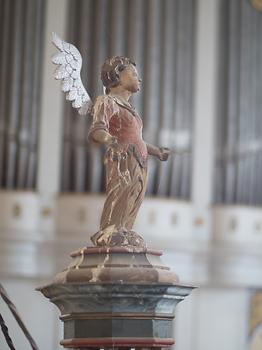Cloaşterf (Klosdorf)#
Der kleine Ort Klosdorf Cloaşterf, Romania liegt ca. 5 km südlich von Saschiz.- Der folgende Text und alle Bilder sind © Heimo Müller, Sommer 2016
Der Ort Klosdorf, rumänisch Cloasterf, wurde 1332 ertsmals urkundlich erwähnt. Kurz darauf ist bereits die Nikolauskirche (1353) bekannt, deren Taufbecken in der heutigen Kirche zu finden ist. Die heutige Kirche wurde zwischen 1521 und 1524 von Baumeister Stefan Ungar aus Schäßburg errichtet.
Die Befestigungsmauer hat vier Ecktürme, 1819 wurde der Südwestturm durch den heutigen Glockenturm ersetzt. Die Kirchenburg in Klosdorf hat eine „defensive Plattform“, bestehend aus einer Saalkirche mit einem polygonalem Chor und einem Wehrgeschoss mit Pechscharten zwischen den Strebepfeilern. Die Brüstung der im Kirchenschiff dreiseitig umlaufenden Empore ist mit floralen Motiven und Darstellungen von anderen Kirchenburgen bemalt. Der Orgelaltar besteht aus dem Altarunterbau von 1716, auf den 1832 eine neue Orgel gesetzt wurde. Hinter der Orgel befindet sich die älteste Bauinschrift Siebenbürgens: „1524 hec structura finita est per me, Stephanu Ungar: Schesesburg“.
- The following text and all pictures are © Heimo Müller, summer 2016.
Cloaşterf, the former Klosdorf, was first mentioned in a document in 1332. Shortly afterwards, the St. Nicholas Church (1353) is yet mentioned, whose baptismal font can be seen in the present-day church. The present-day church was built between 1521 and 1524 by the master builder Stefan Ungar from Sighișoara.
The fortification wall has four turrets, in 1819 the southwestern tower was replaced by the present bell tower. The fortified church in Cloaşterf has a 'defensive zone', consisting of a one-aisled church with a polygonal choir and a defensive floor with slits for pitch between the buttresses. The parapet of the three-sided gallery in the church nave is painted with floral motifs and depictions of other fortified churches. The altar consists of a substructure from 1716, on which a new organ was superimposed in 1832. Behind the organ you can find the oldest building inscription in Transylvania:'1524 hec structura finita est per me, Stephanu Ungar: Schesesburg'.




















